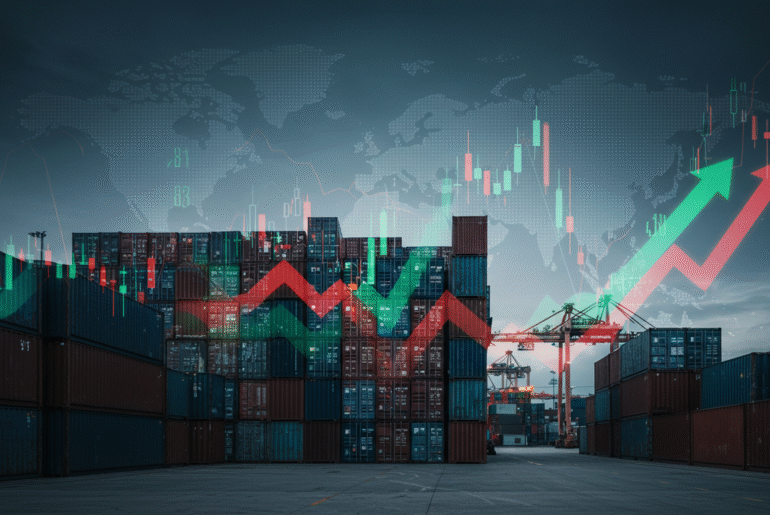This article may contain references to products or services from one or more of our advertisers or partners. We may receive compensation when you click on links to those products or services. Nonetheless, our opinions are our own.
The information presented in this article is accurate to the best of our knowledge at the time of publication. However, information is subject to change, and no guarantees are made about the continued accuracy or completeness of this content after its publication date.
- Tariff Investing Strategy in a Shifting Market
- Tariff Changes and Their Immediate Impact on Investments
- Market Trends Shaped by Tariffs and Portfolio Implications
- Risk Mitigation Strategies for Tariff-Driven Markets
- Investment Opportunities Amid Tariff Announcements
- Tracking Trade Policies to Inform Financial Decisions
- Actionable Steps for Wealth Management During Trade Shifts
- Frequently Asked Questions
- What are tariffs and why do they matter?
- How do tariff announcements impact the markets?
- Who is typically affected by these tariff announcements?
- What should investors consider when tariffs are announced?
- Are there any past examples that illustrate the impact of tariffs?
- What might future tariff announcements signal for the economy?
- Summary of Tariff Investing Strategy
- Recommended Reads
Tariff Investing Strategy in a Shifting Market
You might find yourself refreshing your news feed, waiting to see the latest growth and how it could impact your portfolio. Each day brings a new headline, and with it, a fresh wave of uncertainty. By understanding the implications of these tariffs, you empower yourself to make informed decisions in an environment that can seem chaotic and unpredictable. So, what do these announcements really mean for you and the markets at large? Let’s break it down and equip you with the insights you need to navigate this ever-evolving landscape.
Tariff Changes and Their Immediate Impact on Investments
With recent tariff changes rolling out, it’s crucial to grasp how these adjustments could immediately influence your investment portfolio. Generally, tariff increases can lead to costlier imports, which may, in turn, escalate prices for consumers. Consider the following potential impacts on your investments:
- Sector Vulnerability: Industries like manufacturing and retail are often hit hardest by tariffs, as their supply chains may become more expensive.
- Commodity Prices: Tariffs can also affect commodity prices, such as increased tariffs on steel impacting construction costs.
- Market Sentiment: Heightened tariffs can stir market volatility, influencing investor behavior and stock fluctuations.
| Sector | Impact of Tariff Change | Recommended Action |
|---|---|---|
| Technology | Minimal direct impact; potential supply chain disruptions. | Hold steady, and monitor supply chain news. |
| Consumer Goods | Price increases could lead to reduced demand. | Consider diversifying away from heavily affected brands. |
| Energy | Tariffs on imports can affect prices; geopolitical tensions may rise. | Evaluate positions in energy stocks; assess risk tolerance. |
Market Trends Shaped by Tariffs and Portfolio Implications
Tariffs can create meaningful ripples across the markets, affecting everything from stock prices to commodity values. When a government imposes tariffs on imported goods, it typically aims to protect domestic industries. However, this can lead to increased production costs for companies that rely on imported materials. Consequently, you might notice some sectors thriving while others struggle. Industries such as technology and manufacturing could see increased pressure, while local producers in certain sectors might benefit from reduced foreign competition.
It’s crucial to keep an eye on the sectors most impacted by tariffs to make informed decisions for your portfolio. Here’s a swift overview of potential effects:
- Increased Costs: Companies importing goods may raise prices, impacting consumer spending.
- Market Volatility: Uncertainty around tariffs can lead to stock price fluctuations.
- Sector Performance: Watch for growth in industries that may benefit from reduced import competition.
| Sector | Potential Impact | Investment Chance |
|---|---|---|
| Technology | High risk due to reliance on components | Consider stocks with diverse supply chains |
| Manufacturing | Increased costs may affect margins | Look for companies adapting to changes |
| Consumer Goods | Price hikes may impact sales | Invest in local producers |
Risk Mitigation Strategies for Tariff-Driven Markets
In a tariff-driven market environment, staying ahead of potential economic downturns requires strategic foresight. Here are some effective strategies to help you navigate these turbulent waters:
- Diversify your investments across various sectors.
- Monitor supply chains and explore alternatives in unaffected regions.
- Adjust pricing strategies to reflect tariff-related cost increases.
- Use hedging instruments like options or futures to manage volatility.
- Stay informed with timely updates on trade policy and tariffs.
| Strategy | Action |
|---|---|
| Diversification | Invest in multiple sectors |
| Pricing Adjustments | Revise prices to account for costs |
| Hedging | Explore options and futures |
Voted "Best Overall Budgeting App" by Forbes and WSJ
Monarch Money helps you budget, track spending, set goals, and plan your financial future—all in one app.
Get 50% OFF your first year with code MONARCHVIP
Investment Opportunities Amid Tariff Announcements
When a new tariff proclamation breaks, it can feel like a storm cloud looming over the markets. However, amidst the uncertainty, seasoned investors know these moments can present unique opportunities. Here’s what to keep an eye on:
- Identify sectors likely to benefit or suffer due to tariffs.
- Track commodity price movements as signals for potential entry points.
- Monitor long-term industry shifts driven by evolving trade policies.
| Sector | Potential Impact |
|---|---|
| Importers | Higher costs may decrease profit margins |
| Exporters | Stronger domestic sales with potential growth |
| Consumers | Potential rise in prices on certain goods |
Tracking Trade Policies to Inform Financial Decisions
In today’s fast-paced financial landscape, staying ahead of trade policy announcements can be a game-changer for your investment decisions. Whenever new tariffs are introduced, they can ripple through various sectors, impacting everything from supply chains to consumer prices. By monitoring these developments closely, you can position yourself advantageously. Here are a few ways to stay informed:
- Follow credible news sources for real-time updates.
- Set alerts using platforms like Google Alerts.
- Engage with expert commentary and market analysis.
| Sector | Impact of Tariffs |
|---|---|
| Manufacturing | Increased costs for raw materials, potential price hikes for consumers |
| Retail | Pared-down profit margins, shifts in consumer purchasing patterns |
| Energy | Volatility in prices due to supply chain disruptions |
Actionable Steps for Wealth Management During Trade Shifts
When faced with trade uncertainty, it’s essential to take proactive measures to safeguard and enhance your financial health. Here are some practical steps you can implement:
- Diversify your assets across various sectors and regions.
- Regularly review your portfolio for alignment with your goals.
- Increase cash reserves to leverage market dips or cover unexpected costs.
- Stay current with economic trends and trade developments.
- Consult with a financial advisor for expert guidance.
| Investment Option | Risk Level | Potential Return |
|---|---|---|
| Domestic Stocks | High | Typically high, but volatile |
| Bonds | Low to Moderate | Steady but lower than stocks |
| Real Estate | Moderate | Appreciation plus rental income |
| Commodities | High | Varies widely based on market |
Frequently Asked Questions
What are tariffs and why do they matter?
Tariffs are taxes imposed by a government on imported goods. They are designed to protect domestic industries from foreign competition by making imported products more expensive. This can influence market prices, consumer choices, and trade relations between countries.
How do tariff announcements impact the markets?
Tariff announcements can create volatility in the markets. Investors may react to the prospect of increased costs for businesses, potential changes in consumer spending, and disruptions in supply chains. Such reactions can lead to fluctuations in stock prices and affect overall market sentiment.
Who is typically affected by these tariff announcements?
Various stakeholders are affected, including consumers, domestic manufacturers, exporters, and foreign companies. For consumers, tariffs can lead to higher prices on goods. For manufacturers, tariffs might protect local jobs, but they can also raise costs for materials sourced from abroad.
What should investors consider when tariffs are announced?
Investors should assess the potential impact of tariffs on specific industries and sectors. It’s essential to monitor how tariff changes might influence earnings projections, consumer behavior, and international relations. Diversifying a portfolio and staying informed about geopolitical developments can also help mitigate risks.
Are there any past examples that illustrate the impact of tariffs?
Yes, there are several notable examples, such as the U.S.-China trade war that began in 2018. Tariffs imposed during this period led to significant market fluctuations, disrupted supply chains, and altered global trade dynamics. Observing these past events can provide insights into how current tariff announcements might unfold.
What might future tariff announcements signal for the economy?
Future tariff announcements could indicate shifts in trade policy, economic priorities, or diplomatic relations. They may reflect a government’s strategy to protect certain industries or assert its economic stance on the global stage. Keeping an eye on these signals can provide clues about potential market trends and economic outlooks.
Summary of Tariff Investing Strategy
Tariff changes are more than just headlines; they’re powerful signals that can reshape entire sectors and redefine investment strategies. While the uncertainty around trade policies can introduce volatility, it also opens up room for strategic planning and opportunity. By understanding the sectors most affected, monitoring trends, and applying sound risk management techniques, investors can respond with confidence rather than react with fear.
Staying diversified, informed, and agile allows for a stronger portfolio even during times of geopolitical tension and policy shifts. Rather than seeing tariffs as threats, investors should view them as factors to weigh carefully, recognizing both the risks and the emerging investment openings they create. With a steady approach and an eye on long-term goals, it’s possible to navigate tariff-driven markets effectively and use them as leverage for growth.

Reviewed and edited by Albert Fang.
See a typo or want to suggest an edit/revision to the content? Use the contact us form to provide feedback.
At FangWallet, we value editorial integrity and open collaboration in curating quality content for readers to enjoy. Much appreciated for the assist.
Did you like our article and find it insightful? We encourage sharing the article link with family and friends to benefit as well - better yet, sharing on social media. Thank you for the support! 🍉
Article Title: Tariff Investing Strategy: How to Adapt Your Portfolio
https://fangwallet.com/2025/07/22/tariff-investing-strategy-how-to-adapt-your-portfolio/The FangWallet Promise
FangWallet is an editorially independent resource - founded on breaking down challenging financial concepts for anyone to understand since 2014. While we adhere to editorial integrity, note that this post may contain references to products from our partners.
The FangWallet promise is always to have your best interest in mind and be transparent and honest about the financial picture.
Become an Insider

Subscribe to get a free daily budget planner printable to help get your money on track!
Make passive money the right way. No spam.
Editorial Disclaimer: The editorial content on this page is not provided by any of the companies mentioned. The opinions expressed here are the author's alone.
The content of this website is for informational purposes only and does not represent investment advice, or an offer or solicitation to buy or sell any security, investment, or product. Investors are encouraged to do their own due diligence, and, if necessary, consult professional advising before making any investment decisions. Investing involves a high degree of risk, and financial losses may occur including the potential loss of principal.
Source Citation References:
+ Inspo
There are no additional citations or references to note for this article at this time.












































